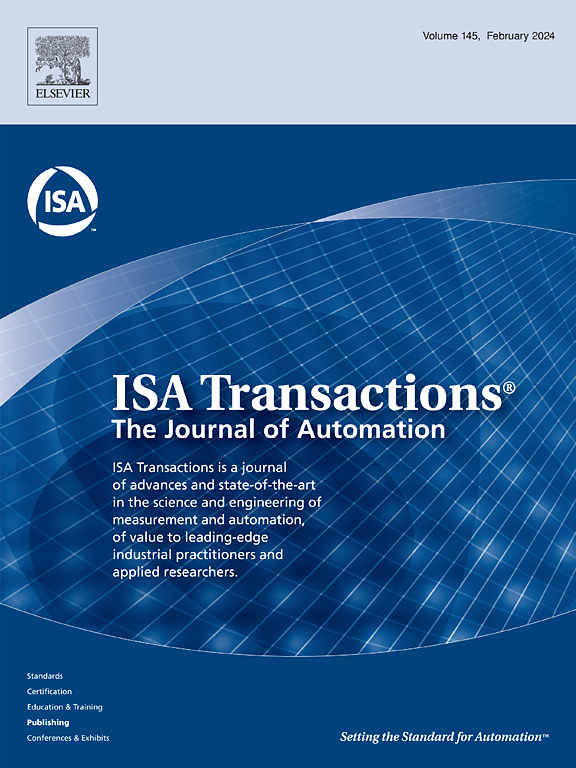基于模型参数估计的1型糖尿病血糖调节优化非线性鲁棒控制器。
IF 6.3
2区 计算机科学
Q1 AUTOMATION & CONTROL SYSTEMS
引用次数: 0
摘要
葡萄糖是细胞的基本能量来源,在各种生理过程中起着关键作用,包括代谢、信号传导和细胞控制。维持血糖水平的精确调节对整体健康和平衡至关重要。为了达到这种平衡,在睡眠期间口服或通过人工胰腺(AP)施用胰岛素,利用基于数学模型的控制算法来调节血糖浓度(BGC)。扩展Bergman最小模型(EBMM)是一个先进的数学框架,它包含一个状态变量,以适应由膳食摄入或运动引起的糖燃烧等因素引发的胰岛素水平紊乱。在我们的研究中,我们提出了鲁棒非线性控制器:自适应反演滑模控制(AB-SMC)和自适应反演积分超扭转滑模控制(ABIST-SMC),并将它们与反演滑模控制(B-SMC)进行比较,以稳定1型糖尿病患者的BGC。这些控制器旨在通过提供鲁棒和自适应控制策略来调节1型糖尿病患者的血糖水平,减轻干扰并确保稳定性,最终提高健康结果和生活质量。此外,还引入了自适应参数估计,消除了控制设计对精确模型参数值的需求。控制器增益采用改进的灰狼优化,以积分时间绝对误差作为目标函数。值得注意的是,ABIST-SMC控制器是最有效的,在不到1.92分钟的时间内达到了期望的降低水平。使用李雅普诺夫控制理论严格分析了所提出控制器的稳定性,证明了它们能够实现渐近稳定。通过仿真来评估和比较所建议控制器的性能。此外,使用硬件在环实验设置执行硬件验证。本文章由计算机程序翻译,如有差异,请以英文原文为准。
Optimized nonlinear robust controller along with model-parameter estimation for blood glucose regulation in type-1 diabetes
Glucose acts as a fundamental energy source for cells and plays a pivotal role in various physiological processes, including metabolism, signaling, and cellular control. Maintaining precise regulation of blood glucose levels is crucial for overall health and equilibrium. To achieve this balance, insulin is administered either orally or through an artificial pancreas (AP) during sleep, utilizing control algorithms based on mathematical models to regulate blood glucose concentration (BGC). The extended Bergman minimal model (EBMM) is an advanced mathematical framework that incorporates a state variable to accommodate disturbances in insulin levels triggered by factors such as meal intake or exercise-induced sugar burning. In our study, we propose robust nonlinear controllers: adaptive backstepping sliding mode control (AB-SMC), and adaptive backstepping integral super twisting sliding mode control (ABIST-SMC) and compare these with the backstepping sliding mode control (B-SMC) for stabilizing BGC in type 1 diabetic patients. These controllers aim to regulate blood glucose levels in type 1 diabetic patients by providing robust and adaptive control strategies that mitigate disturbances and ensure stability, ultimately enhancing health outcomes and quality of life. Moreover, adaptive parameter estimation is incorporated to eliminate the need for exact model parameter values for control design. The controller gains are meticulously fine-tuned using improved grey wolf optimization, with the integral time absolute error serving as the objective function. Notably, the ABIST-SMC controller emerges as the most efficient, achieving the desired reduction level in less than 1.92 min. The stability of the proposed controllers is rigorously analyzed using the Lyapunov control theory, demonstrating their capability to achieve asymptotic stability. Simulations are conducted to evaluate and compare the performance of the suggested controllers. Additionally, hardware validation is executed using a hardware-in-loop experimental setup.
求助全文
通过发布文献求助,成功后即可免费获取论文全文。
去求助
来源期刊

ISA transactions
工程技术-工程:综合
CiteScore
11.70
自引率
12.30%
发文量
824
审稿时长
4.4 months
期刊介绍:
ISA Transactions serves as a platform for showcasing advancements in measurement and automation, catering to both industrial practitioners and applied researchers. It covers a wide array of topics within measurement, including sensors, signal processing, data analysis, and fault detection, supported by techniques such as artificial intelligence and communication systems. Automation topics encompass control strategies, modelling, system reliability, and maintenance, alongside optimization and human-machine interaction. The journal targets research and development professionals in control systems, process instrumentation, and automation from academia and industry.
 求助内容:
求助内容: 应助结果提醒方式:
应助结果提醒方式:


